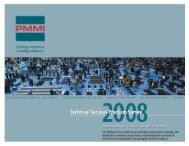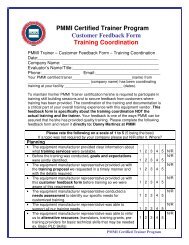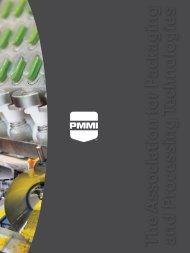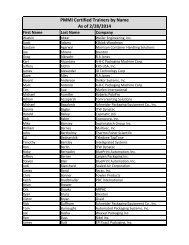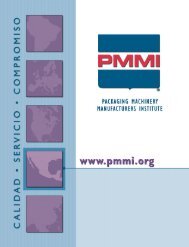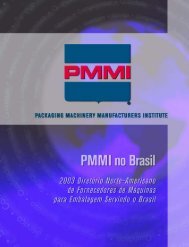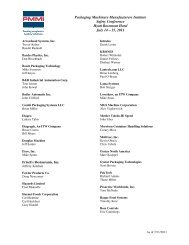Canadian Packaging Machinery Market Research Report - PMMI
Canadian Packaging Machinery Market Research Report - PMMI
Canadian Packaging Machinery Market Research Report - PMMI
You also want an ePaper? Increase the reach of your titles
YUMPU automatically turns print PDFs into web optimized ePapers that Google loves.
34.7 liters, a 25.7 percent increase over 2000. The <strong>Canadian</strong> bottled water industry<br />
now has 77 bottlers producing shipments valued at $C586 million, of which 47.9<br />
percent was exported to the United States in 2002. Canada has now surpassed<br />
France as the largest exporter of bottled water to the U.S., and <strong>Canadian</strong> exports are<br />
expected to double in the next five years.<br />
The <strong>Canadian</strong> soft drink industry primarily serves the domestic market. Statistics<br />
Canada data show that in 2001, 95.1 percent of shipments were for the domestic<br />
market while the remaining 4.9 percent were exported. More than one third of<br />
industry shipments originate in Ontario and one-quarter originate in Quebec. The<br />
remainder is manufactured in the Western provinces while a minor portion comes<br />
from the Maritimes, primarily New Brunswick. Data from Statistics Canada indicate<br />
that per capita consumption of carbonated soft drinks was 113.24 liters in 2001, a<br />
0.43 percent increase over 2000. Data from Retail Sales in <strong>Canadian</strong> Grocery<br />
Stores, 2001, a report AC Nielsen Canada produced for Agriculture and Agri-Food<br />
Canada, indicate that about 23 percent of soft drinks sold are diet drinks and that 77<br />
percent of soft drinks sold are regular drinks. The same study also indicated that<br />
about 52 percent of soft drinks sold are packaged in bottles and that about 48<br />
percent of soft drinks sold are packaged in cans.<br />
Canada’s tea & coffee manufacturers mainly serve the domestic market. Statistics<br />
Canada data show that in 2001, 67.7 percent of industry shipments were for the<br />
domestic market, while the remaining 32.3 percent were exported. The majority of<br />
<strong>Canadian</strong> tea processing takes place in Ontario, Quebec and British Columbia,<br />
although there are many small and medium-sized <strong>Canadian</strong> owned firms located<br />
across the country. Coffee processors are located mainly in Ontario and Quebec,<br />
with small and medium-sized firms located across the country. From 1990 to 1999,<br />
per capita consumption of tea has increased from 0.54 kilograms (tea leaves) to 0.86<br />
kilograms. Data from the Tea Council of Canada indicate that 90 percent of <strong>Canadian</strong><br />
adults drink tea and that they consume some 7 billion cups per year. Per capita<br />
consumption of coffee has increased slightly since 1990 from 4.27 kilograms (beans)<br />
to 4.52 kilograms in 1999. According to the Coffee Association of Canada, adult<br />
<strong>Canadian</strong>s drink over 15 billion cups of coffee per year, making coffee Canada’s<br />
favorite hot beverage. The average coffee drinker in Canada drinks three cups of<br />
coffee each day. Of all coffee consumed in Canada, 74 percent is roast and ground,<br />
20 percent is instant, and 6 percent is specialty. Decaffeinated coffee represents 9<br />
percent of total coffee consumption.<br />
SMG/Columbia Consulting Group Page 134



